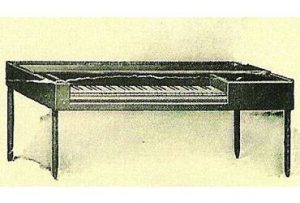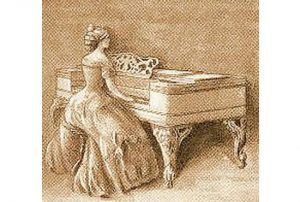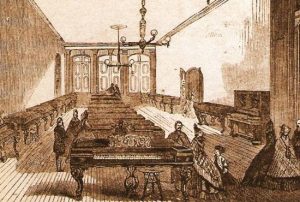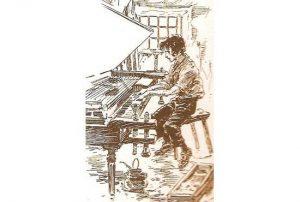Questions? Email Our Experts!
For nearly 150 years, Square Grand Pianos were the piano of choice in both America and Europe, yet very few people today have ever seen one! Even most Piano tuners and technicians today have little or no familiarity with Square Grand Pianos whatsoever.

The Antique Piano Shop is one of the first and only shops of its kind that specializes in the restoration and preservation of the Square Grand Piano. Although the internet provides a significant amount of information regarding traditional Grand and Upright Pianos, there seems to be a substantial lack of credible information and resources regarding Square Grand Pianos. For years, our artisans have rebuilt Square Grand Pianos for clients all over the United States and Canada.
Since square grand pianos have been out of production for over 125 years, parts for these pianos have not been made available to the industry for decades. Our artisans and craftsmen actually manufacture these obscure parts “in house”, making Antique Piano Shop one of the only resources for proper square grand restoration in North America. We have likely restored more Square Grand Pianos than anyone else in the industry!
The Antique Piano Shop was founded on the love and passion for historical Pianos. Our crew consists of specialized Piano Technicians, Historians, Wood Workers, Artisans and Pianists that come together to offer this very specialized niche resource for the Square Grand Piano.

The History and Evolution of the Square Grand Piano
Sometimes referred to by old-timers as a Box Grand, the Square Grand Piano is an earlier form of Piano that is built in a rectangular shaped cabinet, sitting on four legs, with its strings running left to right. During the 18th and 19th Centuries, more Square Grand Pianos were built and sold in America and Europe than any other type of pianos combined! Today, however, they are all but extinct.
The Evolution of the Piano
Before the Piano, there was the Harpsichord, Clavichord, and the Spinet. Rather than having hammers that strike the strings as they do in a Piano, these early instruments got their sound from the strings being plucked by quills (Harpsichords & Spinets) or by being struck by a small metal tangent (Clavichord). These early instruments had very little, if any, dynamic capability and they were not able to be played loudly or softly at will. In addition to these instruments, there was also the Hammered Dulcimer. The Hammered Dulcimer was an instrument frequently used in early music when dynamic capability was desired. Rather than having a keyboard, its strings were struck by hand held, leathered covered hammers which could produce both loud and soft tones at will. The harder the strings were struck, the louder the tone. The ability to add dynamic capability was very important in the evolution of music at that time.
The Grand Piano
About 300 years ago, an Italian Harpsichord maker named Bartolomeo Cristofori came up with an idea of crossing a Hammered Dulcimer with a keyboard similar to a Harpsichord. This invention was called the Piano-Forte, meaning “soft and loud”. These early Pianos looked very much like the then traditional Harpsichord in shape and size, with their strings stretching from the front to the back of the instrument. Even after 300 years of evolution, one can still see the same basic design in the modern Piano and its Harpsichord ancestor.
The Square Grand Piano
In 18th Century Europe, the Piano-Forte was becoming more and more popular, quickly gaining favor over earlier traditional instruments. During the first part of the 18th Century, Piano-Fortes continued to be patterned after the shape and size of the Harpsichord. In about 1760, makers began building small rectangular shaped Piano-Fortes based on the shape and size of the Clavichord. The strings in these instruments ran from left to right rather than front to back as they did in grand piano-fortes. These early rectangular pianos quickly gained great popularity because they were smaller and more stylistically accepted in most European households. These early instruments were to be the first Square Grand Pianos, a design and style that would continue to evolve for almost 150 years.
The “Cocked Hat” Grand Piano
Today’s traditional Grand Piano was patterned after theHarpsichord, and the Square Grand Piano was patterned after the Clavichord. The “Cocked Hat” Grand Piano is basically a Piano that was patterned after the shape and overall design of the Spinet.Cocked Hat Pianos are exceedingly rare, and their scarcity today suggests that very few of them were actually built. What limited information we have about them suggests that they were marketed mostly in the mid-19th Century era prior to the Civil War. We have seen and restored at least one specimen that was built as late as 1890. Mechanically they are designed and built the same as the 19th Century Square Grand Piano, but their shape and stringing pattern is very different. Rather than being strung from front to back (as in a Grand Piano) or from side to side (as in a Square Grand Piano), Cocked Hat Pianos have the strings fanned out in an unusual angle that could almost be described as diagonal. Although these Pianos are exceedingly rare, they deserve mentioning here, and we define them as being a part of the Square Grand Piano family.
The Square Grand Piano in America
In the last part of the 18th Century, John Jacob Astor started importing Square Grand Pianos to America from Europe. By the turn of the 19th Century, a handful of makers are recorded as having made some of the first Square Grand Pianos in America. For the next 100 years, the Square Grand Piano would evolve into a larger, heavier, and more mechanically refined instrument. During the 19th Century, American Piano Makers built and sold more Square Grand Pianos than Grand Pianos or Upright Pianos! Our vintage ephemera collections show these Square Grand Pianos selling for as much as $800 in the mid 19th Century – the cost of a small house! Sadly, however, they are all but forgotten today.By about 1880-1890, the American Upright Piano began to win favor as being more fashionable than the Square Grand Piano. Because they were smaller and took up less floor space, the Upright Piano caused the Square Grand Piano to become obsolete by 1900.
20th Century Extinction
Square Grand Pianos were very large and very heavy musical instruments. They were not easily moved. They were reminders of the gilded Victorian age, often very elaborate and ornate. As 20th Century America began to streamline in style and become a modern industrialized nation, these beautiful Pianos quickly became out-dated and served as garish reminders of another time. Sadly, for the past 100 years, Square Grand Pianos have consistently been chopped up, burned, or otherwise destroyed and lost forever.
21st Century Revival
Today, there is a huge renaissance for the Square Grand Piano in America. Once again, collectors and musicians alike are beginning to appreciate and preserve these amazing instruments, and they are becoming potentially quite valuable. With American values and sense of family heritage stronger today than ever, these heirloom instruments are once again finding their rightful place in our society, in our homes, and in our hearts.











Correcting Common Misconceptions about Square Grand Pianos
Often misunderstood, antique Square Grand Pianos have suffered terrible prejudice by the modern piano industry. We routinely hear stories from clients who tell us that their highly regarded Piano Tuner tells them that their Square Grand Piano isn’t worth its weight in firewood, and that investing in restoration & preservation would be fruitless.
Piano Tuners and Square Grands
Consider this: Today’s average senior Piano Tuner/Technician would likely be about 50 to 70 years old. When he learned to tune and repair Pianos decades ago, Square Grand Pianos were already 100+ year old antiques! As a result, no one alive today can remember these Pianos when they were new and in their prime. Piano Tuners tell us that they simply never had a chance to see and hear a Square Grand Piano that was in good working order because they were “ancient” Pianos in disrepair for as long as they could remember.
Tuning Square Grand Pianos
Some Piano Tuners will tell you that Square Grand Pianos can’t be tuned. This is true if a Square Grand Piano is in original, unrestored condition. What they DON’T tell you is that a 100 year old Upright or Grand Piano that is in original, unrestored condition can’t be tuned either! This is because of the fact that the old strings, felt and leather tend to deteriorate over time. There is an estimated 12-14 tons of tension on a Piano when it is in tune. When this tension is put back on these deteriorated components, they simply can’t hold it, causing the Piano to be unable to hold tune properly. Again, this is the case with any 100 year old Piano, not just Square Grand Pianos.
Since Square Grand Pianos were built so long ago, their tuning pins are shaped differently than modern tuning pins. Most modern tuning equipment doesn’t fit an original square grand piano’s tuning pins. This often causes further prejudice among many unprepared piano tuners.Note that when a Square Grand Piano is properly restored, the tuning pins are replaced with standard tuning pins so that that ANY piano tuner can tune it (with the exception of early historical forte-pianos which require a much smaller diameter tuning pin). Also, the tuning pins are in the back of a square grand piano, causing the piano tuner to have to bend over for a considerable amount of time to tune the instrument. Since most piano tuners keep themselves busy making good money with easier conventional upright and grand piano tuning and servicing, it can sometimes be difficult to find a piano tuner willing to tune a square grand piano even after restoration. In most cases, a piano tuner will charge a bit more for the extra effort involved in tuning a square grand. Finding a piano tuner who loves and appreciates these special pianos is key to keeping your square grand piano in good working order long term.
In summary, with some effort and patience, a properly restored square grand piano can be tuned just fine.
It may be a bit more physically challenging to tune a square grand piano, so your tuner may rightfully charge more than an average service call to tune it.
Why Do Square Grand Pianos Sound Different Than Modern Pianos?
Note: We have found that to the untrained ear, the average person can tell very little difference in the tone of a restored square grand piano compared to a typical new grand or upright piano.
To understand why a Square Grand Piano sounds different than today’s modern instrument, one needs to understand a bit how music has evolved over the centuries. 300 years ago when the Piano was in its infancy, there was no such thing as electronic amplification. The Harpsichord and Clavichord were generally used in small intimate settings, producing adequate volume to fill an ordinary room. The early Piano-Forte had a decided advantage over its predecessors because it was able to produce both loud and soft dynamics, but not to the degree of modern instruments. These early Piano-Fortes had soft, leather covered hammers, and they produced an almost “harp like” quality that really is quite beautiful to listen to.
As the piano continued to evolve into the 19th Century, makers began to build their Pianos larger and heavier, ultimately allowing their strings to handle greater levels of tension. In Grand and Upright Pianos, hammers became covered with hard dense felt rather than the traditional softer leather covered hammers of their predecessors. As these instruments became larger and more evolved, they also became louder. Higher tension, use of iron frames, and evolving science helped create the loud and powerful Piano that we know today.
By the middle of the 19th Century, the traditional Grand Piano in America had evolved to a point where it sounded almost like the Pianos of today. There is evidence that much of 19th Century America did not like the loud and powerful sound of the evolving “Modern Piano” that was being introduced to them. Some described the tone as “harsh” and “overbearing”, and they preferred the softer, harp like tones of the earlier Piano-Forte that they were accustomed to. We believe that this the prime reason that the softer toned Square Grand Piano continued to be the most popular type of Piano built and sold up until the last part of the 19th Century.
So yes, Square Grand Pianos do sound different than modern Pianos. When composers like Mozart, Chopin, Beethoven, and Schumann wrote their famous Nocturnes and Piano Concertos, they heard the music they wrote on early Piano-Fortes with delicate, beautiful tones. The Square Grand Piano continued to maintain this delicate tone quality throughout its entire existence, even as Grand and Upright Pianos became louder and harsher. More Square Grand Piano were built and sold in the 19thCentury than Upright or Grand pianos, indicating that 19th Century American preferred their tone quality to the more modern tone of the Grand and Upright Pianos.
Note: As the modern piano continues to evolve, the tone is continuing to change. Today, Asian import pianos are offering a “high tension scale” which is yet again increasing the volume of the piano. These pianos tend to have a very glassy and metallic tone quality which is far different from what pianos sounded like just 30 years ago!

Visit Our Gallery & Online Museum
For years, we have been collecting Antique Piano Catalogs and Ephemera as it relates to antique Pianos. Displayed here is part of our extensive collection as it relates to the antique pianos, organs, and especially square grand pianos. Listed by brand name, these catalog excerpts tell an amazing story about how important the Square Grand Piano was in 19th Century America! Our gallery and online museum can be seen by clicking on the following link: https://www.antiquepianoshop.com/online-museum/
Square Grand Pianos For Sale
Listed at the following link is our online showroom gallery which features some of the Square Grand Pianos we currently have available for sale. Also listed are several of the Square Grand Pianos we’ve sold in the past. This gallery is designed to give you a general idea what Square Grand Pianos look like before and after restoration, and also to give the general public an accurate sense of the real market value for these restored instruments. Our entire online showroom can be seen at the following link: https://antiquepianoshop.com/product-category/square-grand/
Square Grand Restoration Services
At the Antique Piano Shop, we specialize in restoring Square Grand Pianos for individuals who desire to preserve their heirloom instruments. We venture to say that we have likely restored more Square Grand Pianos than anyone else in the industry.
Since Square Grand Pianos are so rare today, parts and supplies are not readily available for them by most piano supply companies as they are for conventional Grand and Upright Pianos. This is one of the reasons that most shops won’t rebuild Square Grand Pianos. We have most of our parts custom made for each piano, and everything else we actually make ourselves.
It seems that we are about the only company that specializes in Square Grand Piano restoration and preservation. Square Grand Piano restoration is not a quick and easy way to make money. It is a very specialized craft that takes a lot of time, patience, and attention to detail. Piano Tuners will often tell you that Square Grand Pianos are worthless or impossible to restore simply because they are not willing to invest the time and attention required to restore them. More often than not, these Piano Tuners are not familiar enough with Square Grand Pianos to give them an accurate evaluation.
LET US RESTORE YOUR SQUARE GRAND PIANO
Right now we are accepting a limited number of new projects for our restoration shop. If you would like to get an accurate price quote to have your instrument restored, please go to this link and submit the requested information as accurately as possible: https://www.antiquepianoshop.com/restoration-services/restoration-packages/square-grand-piano-restoration-packages/






